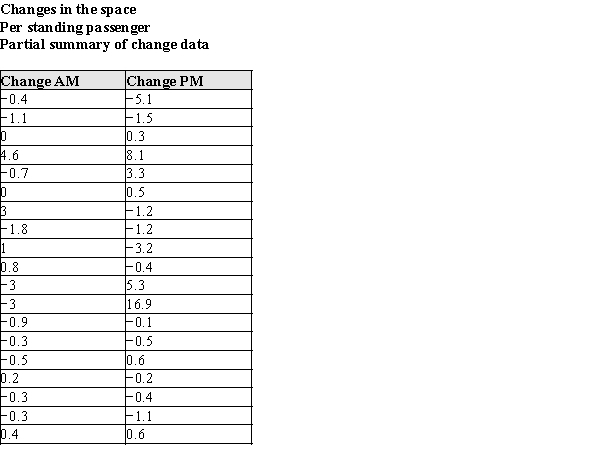The data in the table below are the changes in the amount of space available to standing passengers at the 19 stops between 1987 and 1988.  In the table below, summary information is presented for these data.
In the table below, summary information is presented for these data. 

(a)Using the raw data and summary information presented in the tables above, construct box plots to compare the changes in available space the morning and afternoon. (Reminder: Don't forget to check for outliers!)(b)The Transit System wishes to know if their efforts to improve the standing space were successful. (Remember, more space is better!) Their engineers had suggested that the changes in the system would, on average, be more successful at increasing the available space in the morning than in the afternoon. Does the data support this initial belief? What specific aspects of the plot in part (a) support your answer?
(c)Using your box plots in part (a), write a short paragraph for the New York Times describing the success the Transit System had in increasing the available space per passenger. Note any differences in success between the morning rush and the afternoon rush.
Definitions:
Consolidated Balance Sheet
A financial statement that aggregates the assets, liabilities, and equity of a parent company and its subsidiaries into one document for a clear view of the total business.
Contingent Consideration
An obligation of an acquiring entity to transfer additional assets or equity interests if future events occur or conditions are met, following an acquisition.
Goodwill Impairment
A reduction in the book value of goodwill, which occurs when the carrying amount of goodwill exceeds its fair value, indicating that the asset is not as valuable as previously thought.
Reporting Units
Segments or components of a business for which discrete financial information is available and reviewed by the operating segment's management.
Q3: Data from a poll of adults aged
Q5: Changing the hours of operation for a
Q6: When selecting an appropriate method for data
Q9: The chi-squared test statistic, X<sup>2</sup>, measures the
Q11: If random variables <img src="https://d2lvgg3v3hfg70.cloudfront.net/TB7677/.jpg" alt="If random
Q14: A study determined that in 2009, 38%
Q14: Identify situation when the chi-square goodness-of-fit test
Q36: The following nitrous oxide emissions (in thousands
Q43: Researchers conducted a survey among 1793 families
Q90: Long-term relationships with profitable customers are the